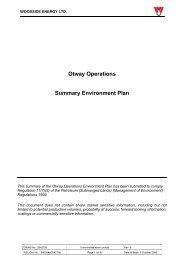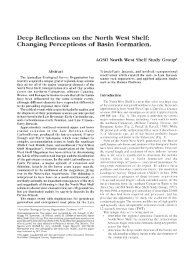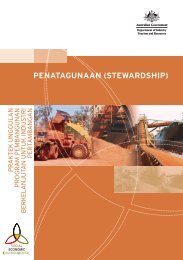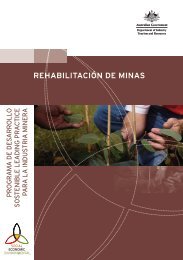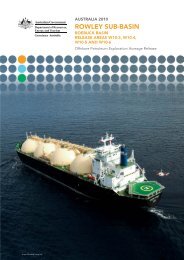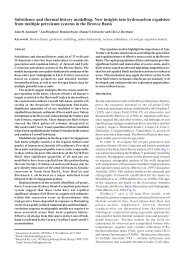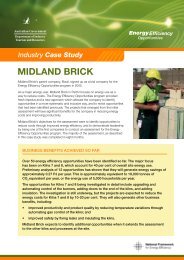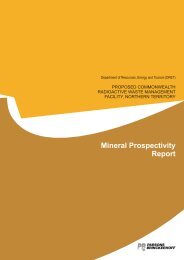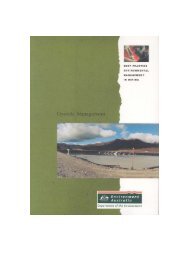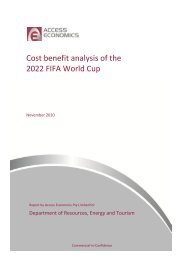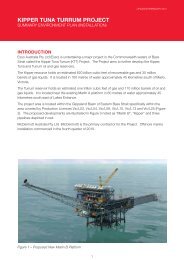A guide to leading practice sustainable development in mining
A guide to leading practice sustainable development in mining
A guide to leading practice sustainable development in mining
You also want an ePaper? Increase the reach of your titles
YUMPU automatically turns print PDFs into web optimized ePapers that Google loves.
Landform construction<br />
In general, erosion of constructed landforms on m<strong>in</strong>e sites is dom<strong>in</strong>ated by<br />
gully<strong>in</strong>g—a direct consequence of concentration of run-off by the berms and<br />
discharge of concentrated flows on<strong>to</strong> batter slopes once the berms fail. The reasons<br />
for berm failure <strong>in</strong>clude <strong>in</strong>accurate construction, tunnel erosion and over<strong>to</strong>pp<strong>in</strong>g due<br />
<strong>to</strong> deposition of sediment. Where erosion rates rema<strong>in</strong> significant (commonly <strong>in</strong> arid<br />
areas where surface vegetation cover is <strong>to</strong>o low <strong>to</strong> provide erosion control) outer<br />
batter profiles that <strong>in</strong>clude berms will require regular ma<strong>in</strong>tenance (de-silt<strong>in</strong>g) as<br />
long as the erosion cont<strong>in</strong>ues, or else they will fill with sediment and over<strong>to</strong>p, caus<strong>in</strong>g<br />
gully<strong>in</strong>g. For this reason, some sites have adopted a <strong>practice</strong> of us<strong>in</strong>g berms or some<br />
form of across-slope bank dur<strong>in</strong>g <strong>in</strong>itial rehabilitation, then remov<strong>in</strong>g the berms once<br />
vegetation has established and stabilised the slope.<br />
Other sites have <strong>in</strong>corporated rock <strong>in</strong><strong>to</strong> the surface of outer batter slopes <strong>to</strong><br />
reduce erosion potential and enable them <strong>to</strong> construct relatively long, high, slopes<br />
without berms. Another option is <strong>to</strong> create concave slope profiles <strong>to</strong> reduce erosion<br />
potential; usually by a fac<strong>to</strong>r of two or three. To develop a new approach <strong>to</strong> waste<br />
dump construction, the Murr<strong>in</strong> Murr<strong>in</strong> nickel m<strong>in</strong>e had the erodibility of a range of<br />
wastes and <strong>to</strong>psoils assessed us<strong>in</strong>g both labora<strong>to</strong>ry and field measurements. Us<strong>in</strong>g<br />
that data and long-term ra<strong>in</strong>fall and climate data for the site, computer simulations<br />
of run-off and erosion were used <strong>to</strong> compare a range of options for outer batter<br />
slopes. Concave slope profiles were developed that had relatively low erosion risk,<br />
though addition of tree debris and laterite gravel was recommended for segments<br />
of the slope that the simulations showed <strong>to</strong> have highest erosion potential (see LP<br />
Moni<strong>to</strong>r<strong>in</strong>g p.45).<br />
Figure 5.26 – Concave waste dump slope at Murr<strong>in</strong> Murr<strong>in</strong><br />
Surface roughness is an important consideration <strong>in</strong> rehabilitation of m<strong>in</strong>e site<br />
landforms. Roughness tends <strong>to</strong> trap water and seed, and there is general acceptance<br />
that a rough surface will provide better vegetation establishment than a smooth one.<br />
However, while the creation of large surface roughness via rip l<strong>in</strong>es or moonscap<strong>in</strong>g<br />
may give benefits <strong>in</strong> the short term, <strong>in</strong> the longer term it may lead <strong>to</strong> <strong>in</strong>creased<br />
erosion and <strong>in</strong>stability of the landform. The value of surface roughness is closely<br />
l<strong>in</strong>ked <strong>to</strong> its persistence through time, which is largely controlled by the particle size<br />
distribution of the material <strong>in</strong> which the roughness is created.<br />
A GUIDE TO LEADING PRACTICE SUSTAINABLE DEVELOPMENT IN MINING 163






